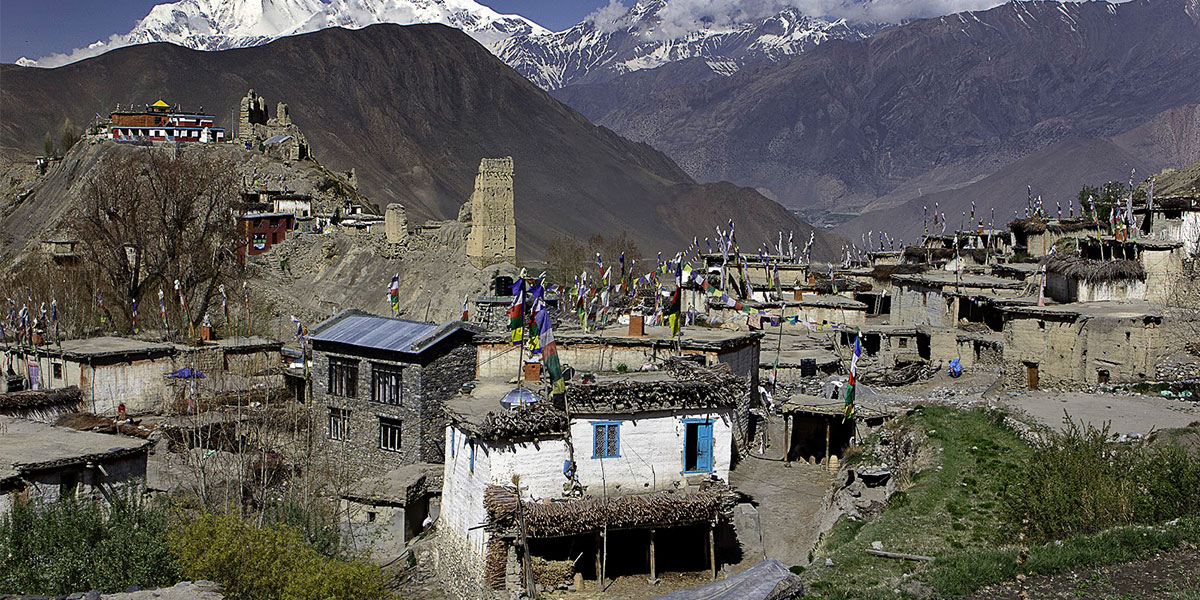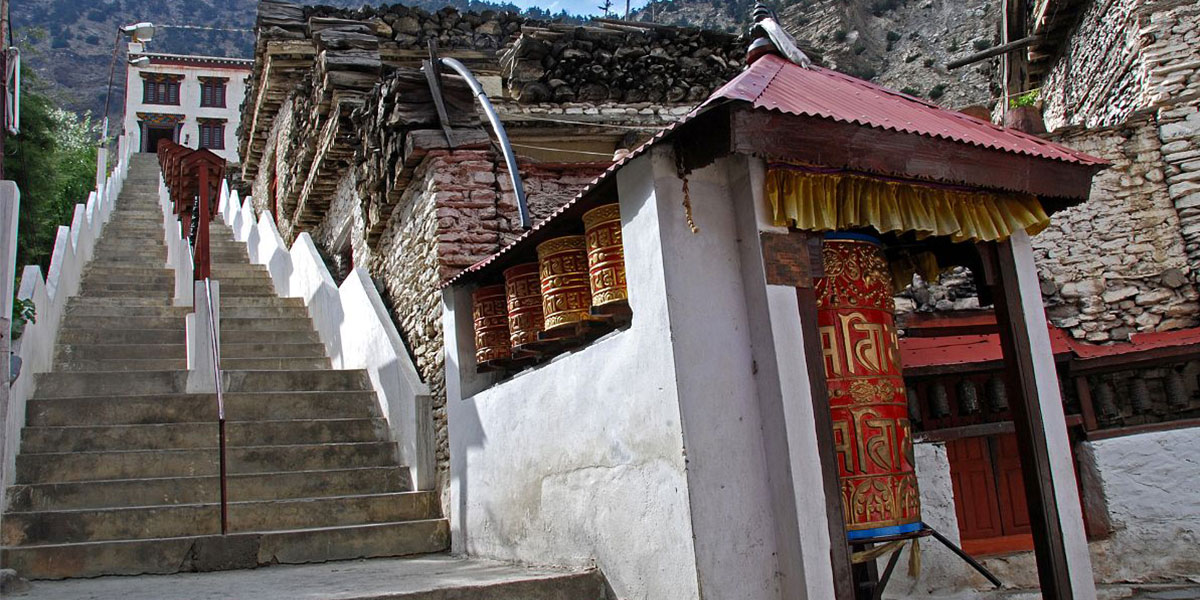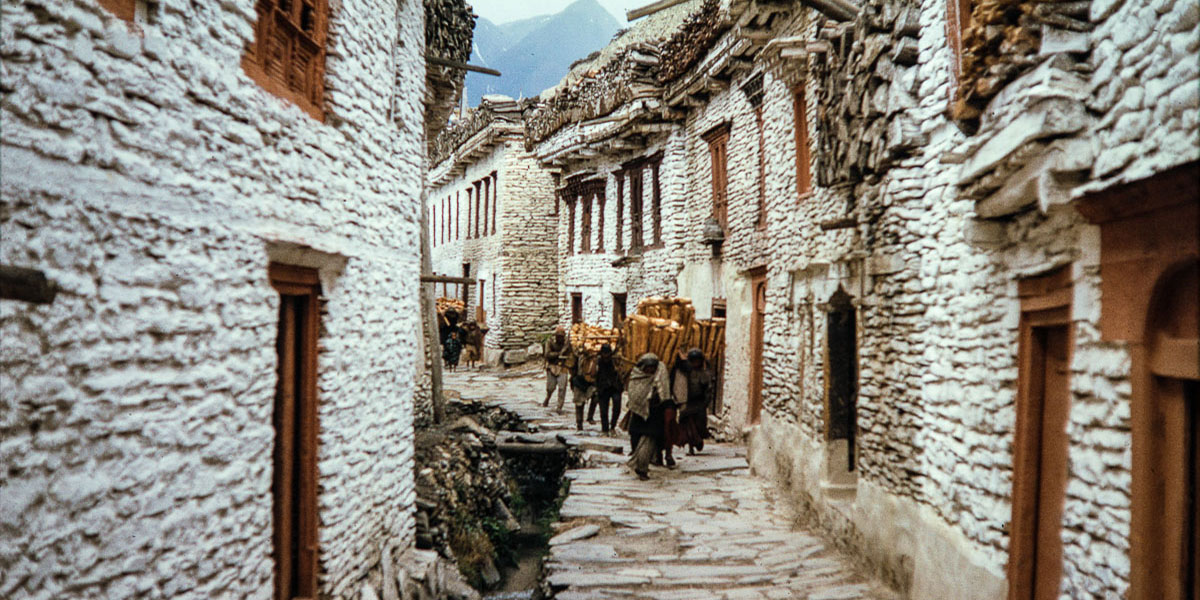Chhertosum (Marpha Hill)
Situated at an altitude of 4360m, Marpha hill is a suitable place for a daylong side trip. It takes 4 to 5 hours to get there. Its main attractions are the numerous Yaks, grazing on a beautiful high altitude pasture (called "Yak Kharka"). It is a gateway to Dhaulagiri base camp and Hidden valley, offers bird's eye view of Muktinath and other villages, and the overwhelming views of Mt. Nilgiri (7060 m), Tilicho Peak (7139 m), Yak Kawa (6482 m), Mesokanto La (pass to reach Tilicho Lake, the highest lake in the world).
Chhairo
It takes about 30 minutes from Marpha. There is a Tibetan refugee camp where more than 200 Tibetans live. A Nyingma-Pa Kagyutpa sect monastery called Chhairo Gompa is close to the camp. This monastery is considered as the most important holy monastery of Buddhist. Chhairo Gompa is said to have been founded by Tibetan Lama named Kusyo Chhiwang Thilen in early 19th century. The monastery depicts images of Shakyamuni flanked on either side by two of his disciples, Ananda and Sariputra and an idol of the founder, Kusyo Chhiwang Thilen. Huge image of Guru Rimpoche (Padmasambhava) is placed in the next room. The frescoes of Chhairo Gompa are the oldest existing works of the Thak Khola region.
Jhong or Dhamang (Old Marpha)
It takes about one and half hours climb to reach Jhong or Dhamang from present day Marpha. From here beautiful scenes of Mt. Nilgiri and river basin of Kali Gandaki can be observed. Jhong was the original Marpha that was shifted long back to the present place. Elevation of Jhong is nearly 3044m. A beautiful apple orchard is located here.
Other attractions
he main attraction of Marpha is numerous beautiful apple orchards. Harvesting time is September. There are three distilleries producing famous apple, peach and apricot brandy and German technology apple dryers (one in big scale). A pleasant walk in the fields and the village gives an insight of the traditional village life. Women are seen in the traditional fashion like Nhakun - Cholo, Tutum with lots of jewelry during the festival and social event.
Horticulture Farm
It was established by the government in 1966. This farm is a pioneering in horticultural development (especially apple) in Mustang. All major temperate fruit trees are available in the farm, thus helping to conserve more than 45 varieties of apples collected from major apple growing countries. The main activities of the centre are research, production, training and out-reach programs for temperate fruit and vegetable crops. It also has fruit-processing unit including brandy distillery.
Pho Lo(Family God)
At the north corner of the village and on the west bank of Pomberkyu Khola, there is a dead twin Juniper tree, which is worshipped as the family god of Thakali community of Marpha. No one knows when it was dead. Surprising thing is that this century old dead and dried tree has no rotten parts. This tree is about 15 meters tall.
Bhra Gompa
Bhra Gompa ("Bhra" means slope) is an enigmatic monastery, the god of which is called Kompa Ngakpa. It is located behind Tashi Lha Khang. The sculpture kept inside of it is not allowed to look believing that people might die soon after seeing the scary image.
Rhingin Komba
Rhingin Komba is a big, triangular - shaped white stone seen on north of the village, on the hill about 50 meters higher. "Rhingin" means "long life" and "Komba" means "holy place". Usually, worshipping takes place during change of "Mukhiya" (village leader). The place offers an excellent view of the Marpha village.
Ekai Kawaguchi's Home
This is a home of Adam Naring, the headman of Marpha where Ekai Kawaguchi, a Japanese Zen monk, stayed for three months in 1900 on his way to Tibet via Dolpo. Ekai Kawaguchi studiedsacred texts of Kangyur and Tengyur in the chapel of this house during his stay.
Tashi Lha Khang Gompa
This is a monastery of Karma-Pa sect located at the centre of the village. The monastery was built more than 200 years ago. Being an offshoot of Karma-Pa Kagyut-Pa sect foundation of Samteling of Mustang, it is known as Samteling Gompa of Marpha. The monastery depicts images of Amitabha (Red Buddha), Chenresig (Avalokiteswora), Channa Dhorje (Vajrapani) and Guru Rimpoche (Padmasambhava) along with other deities and beautiful frescoes. Visitors might encounter Dhekep, a masked dance performed by the monks in October/November.
Marpha village
The village is characterized by the traditional flat mud roofed houses with piles of firewood neatly stacked upon it. Wooden carved windows, long main spotless flagstones, and paved alleys are some of the unique features of Marpha. It is worth visiting the small library at the center of the village or horticulture farm on the southern end of it.



